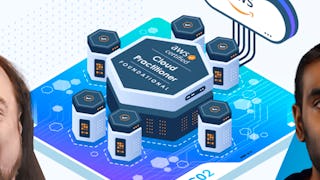The "Foundation to Multi-Cloud" course is designed to provide a comprehensive understanding of multi-cloud computing principles, benefits, and challenges. It equips you with the knowledge and skills required to effectively manage and utilize multiple cloud platforms simultaneously. This course introduces the concept of multi-cloud, elucidates its advantages and complexities, and delves into various strategies and technologies for implementing and managing multi-cloud environments.



(53 reviews)
Recommended experience
What you'll learn
Learn the fundamental principles and benefits of multi-cloud computing, including increased flexibility, scalability, and resilience.
Gain knowledge of the key components & service models in multi-cloud architectures and understand how to design scalable and interoperable solutions.
Explore deployment strategies, such as cloud bursting, workload distribution to optimize application performance & meet specific requirements.
Skills you'll gain
Details to know

Add to your LinkedIn profile
6 assignments
See how employees at top companies are mastering in-demand skills

There are 3 modules in this course
In this module, you will learn about the fundamentals of cloud computing, such as computing, storage, database, networking, and security. Once we have the foundation established, we will discuss the difference between multi-cloud and hybrid clouds, multi-cloud architecture, and cloud service providers.
What's included
7 videos4 readings2 assignments1 discussion prompt
In this module, you will learn about Containerization, its orchestration, and how networking works for containers. Once we get an idea about orchestration and networking, we will go through K8s basics, threat modeling, and, ultimately, hands-on activity on AKS.
What's included
14 videos2 readings2 assignments1 discussion prompt
An introduction to using Terraform for Google Cloud is given in this module. You may utilize some of its primary features and functions to develop and maintain Google Cloud infrastructure, and it allows you to explain how Terraform can be used to implement infrastructure as code.
What's included
18 videos1 reading2 assignments1 discussion prompt
Earn a career certificate
Add this credential to your LinkedIn profile, resume, or CV. Share it on social media and in your performance review.
Explore more from Cloud Computing
 Status: Free Trial
Status: Free Trial Status: Free Trial
Status: Free Trial
LearnKartS
 Status: Preview
Status: Preview
KodeKloud
 Status: Free Trial
Status: Free Trial
Why people choose Coursera for their career




Learner reviews
53 reviews
- 5 stars
98.11%
- 4 stars
0%
- 3 stars
0%
- 2 stars
0%
- 1 star
1.88%
Showing 3 of 53
Reviewed on Apr 6, 2025
It's very interesting and I am learning a lot of new things.
Reviewed on Feb 10, 2025
Comprehensive guide to multi cloud architecture, deployment and management. Ideal for IT professional exploring cloud strategies.Thank you
Reviewed on Feb 10, 2025
?excellent introduction to multi cloud architecture. Covering key concept and best practice for cloud computing. ?

Open new doors with Coursera Plus
Unlimited access to 10,000+ world-class courses, hands-on projects, and job-ready certificate programs - all included in your subscription
Advance your career with an online degree
Earn a degree from world-class universities - 100% online
Join over 3,400 global companies that choose Coursera for Business
Upskill your employees to excel in the digital economy
Frequently asked questions
Using services from many cloud providers simultaneously, such as Amazon Web Services (AWS), Microsoft Azure, and Google Cloud Platform (GCP), is known as multicloud. This strategy helps users avoid vendor lock-in and takes advantage of the distinct advantages of each provider.
Vendor diversity: By utilizing the advantages of several providers.
Reduced Downtime: By redirecting traffic to alternative functioning clouds in the event of a provider failure.
Complexity: Managing several clouds can be challenging.
Cost management: To prevent unforeseen charges.
Assessment: Determine which clouds and services best correspond with the objectives, workloads.
Architecture: Think about how various cloud services will interact while designing your architecture.
Automation and orchestration: Use automation technologies to control the installation, expansion, and upkeep of applications across several clouds.
Monitoring and management: To maintain effective operations, use centralized solutions for performance and security.
More questions
Financial aid available,




